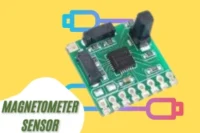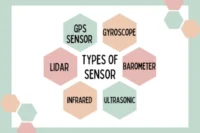What Are the 4 Main Sensors Used in Drones Explained
Published: 1 Aug 2025
In the future, drones will get smarter, but they will still depend on their core sensors. So what are the 4 main sensors used in drones today that form the backbone of this tech? As drone technology grows in farming, filmmaking, and delivery, understanding these basic sensors becomes more important. Most drones rely on a gyroscope, accelerometer, magnetometer, and barometer. These tools help drones stay level, move accurately, find direction, and hold altitude. In this guide, we will explain each sensor’s functionality, importance, and real-world application.
1. Gyroscope: The Balance Keeper
The gyroscope helps drones stay balanced in the air. It senses movement and rotation, allowing the drone to adjust itself quickly and fly smoothly.
Functionality – What It Does
Detects tilt and rotation: It senses how the drone tilts or spins while flying.
Measures angular speed: It tracks how fast the drone moves along three axes—pitch (up and down), roll (side to side), and yaw (turning left or right).
Importance – Why It Matters
Maintains flight stability: It helps the drone stay level and upright during flight.
Prevents shakiness: It reduces unwanted vibrations or wobbles in the air.
Improves control response: It ensures the drone reacts smoothly to pilot inputs.
Application – How It’s Used
In filmmaking: Keeps the drone steady for smooth, stable video footage.
In drone racing: Allows quick, stable turns at high speeds.
In windy conditions: Helps the drone resist flipping or losing balance.
2. Accelerometer: The Motion Detector
The accelerometer helps a drone understand how fast it’s moving and in which direction. It works hand-in-hand with the gyroscope to keep the drone steady and safe during flight.
Functionality – What It Does
Measures speed and direction: It senses how quickly the drone moves forward, backward, up, or down.
Tracks tilt: It detects changes in the drone’s angle, helping it understand its position.
Detects movement shifts: It spots sudden movements or jerks, allowing the drone to react in real time.
Importance – Why It Matters
Supports stable hovering: It helps the drone stay in one spot without drifting.
Works with the gyroscope: Together, they give the drone better balance and control during flight.
Essential for key actions: It helps detect when the drone takes off, lands, or slows down.
Application – How It’s Used
Hovering for inspections or filming: Keeps the drone steady while capturing clear shots or scanning objects.
Assists in obstacle avoidance: It helps the drone detect sudden shifts and make quick adjustments.
Indoor flying support: In places where GPS signals are weak or missing, it helps the drone stay stable and move correctly.
3. Magnetometer: The Digital Compass
The magnetometer acts like a compass inside the drone. It helps the drone figure out which direction it’s facing so it can stay on track during flight.
Functionality – What It Does
Senses the Earth’s magnetic field: It detects natural magnetic forces to find direction.
Determines heading: It tells the drone whether it’s facing north, south, east, or west.
Supports directional accuracy: It works continuously to adjust orientation mid-flight.
Importance – Why It Matters
Keeps drones on course: It ensures the drone stays aligned with its planned route.
Works with GPS systems: It helps provide accurate positioning and navigation, especially over long distances.
Essential for automated return-to-home: The drone uses this sensor to turn and head back to its starting point safely.
Application – How It’s Used
In mapping and surveying: Ensures the drone flies in a straight, precise path while collecting data.
For delivery routes: Helps drones stay pointed in the right direction when delivering packages.
Preset flight paths: Supports features like waypoint navigation and route-following in automated missions.
4. Barometer: The Altitude Helper
The barometer helps a drone understand how high it is in the sky. It uses air pressure to measure altitude and helps keep the drone flying at a steady height.
Functionality – What It Does
Measures air pressure: It senses changes in air pressure to calculate how high the drone is above the ground.
Detects vertical movement: It tracks when the drone is rising or falling, helping it stay in control.
Supports altitude awareness: It continuously updates altitude data during flight.
Importance – Why It Matters
Keeps a steady height: It helps the drone maintain a fixed altitude, avoiding sudden drops or climbs.
Supports smooth takeoffs and landings: It allows the drone to land gently and take off without jerks.
Works with other sensors: It helps create a more stable and controlled flying experience when used with the gyroscope and accelerometer.
Application – How It’s Used
In precision farming: Used for terrain-following so the drone can spray crops evenly across bumpy fields.
For delivery drones: Ensures packages are dropped off from the correct height.
In aerial filming: Keeps the drone flying level to capture smooth and steady video footage.
Conclusion
The four main sensors—gyroscope, accelerometer, magnetometer, and barometer, work together as the brain and body of every drone.
They help the drone stay balanced, move in the right direction, maintain altitude, and fly safely through different environments.
When you understand how these sensors work, flying becomes not only easier but also more fun and reliable—whether you are a beginner, a hobbyist, or using drones for work.
FAQs
Drones need multiple sensors to stay safe, balanced, and accurate while flying. Each sensor does a different job like keeping direction, altitude, or motion in check. Together, they help the drone fly smoothly and respond quickly.
If the barometer fails, the drone might not hold altitude properly. It could rise or drop suddenly. This can make landings rough or filming shaky.
Yes, it’s a good idea to calibrate your sensors before each flight. This helps the drone get accurate readings. Calibration is quick and helps avoid flight problems.
These sensors help the drone stay level, steady, and at the right height. This means smoother videos and clearer photos. They make a big difference in professional filming.





